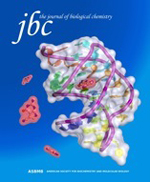Riboswitch Crystal Structure May Lead to New Antibiotic Targets
summary written by Raven Hanna
Like a busy city street needing stoplights to control chaos, cells need constant feedback to govern biochemical pathways. Most organisms engage in a balancing act to control the production of proteins, including the enzymes that produce metabolite molecules necessary for life. Like traffic signals reacting to the amount of traffic, cells can "switch" on or off biosynthetic enzymes depending on the cellular abundance of metabolites. In the past decade, researchers have discovered an elegant control mechanism that involves an unusual switch comprised of ribonucleic acid (RNA). Such 'riboswitches' are present in bacteria as well as some plants and fungi. They are unusual because they exist as segments in messenger (m)RNA, which has traditionally been perceived as only a passive carrier of genetic information connecting the DNA genes to ribosomes, the protein synthesis factories of the cell. When cellular abundance of a specific metabolite is high, the riboswitch region forms a pocket that harbors the metabolite, causing structural changes in the mRNA that physically block sequences critical for mRNA decoding by the ribosome. This causes the amount of the encoded enzyme to decrease and thus the amount of metabolite production to decrease until the metabolite concentration is too low for riboswitch binding. The mRNA is then unblocked and enzyme production begins again.
A research team led by Joseph Wedekind at the University of Rochester Medical Center (NY) crystallized the smallest naturally occurring riboswitch known, preQ1, from the hot spring bacterium Thermoanaerobacter tengcongensis. They solved the structure using MAD phasing at SSRL Beam Line 7-1. The researchers observed that the RNA sequence forms a compact structure with most of the RNA residues making multiple contacts to neighboring bases. Such visualization accounted for the strong binding affinity of the riboswitch to its metabolite and the conservation of specific bases in the RNA sequence.
Because riboswitches regulate the production of as many as 4% of bacterial genes, understanding their form and function relationships may lead to a new way to combat disease-causing bacteria that are resistant to current antibiotics. The researchers will continue to investigate this riboswitch from other bacterial species to determine if this method of metabolite binding and gene regulation is conserved. This work was published in April 24 issue of the Journal of Biological Chemistry.
To learn more about this research see the full Scientific Highlight
Spitale R.C., Torelli A.T, Krucinska J., Bandarian V., Wedekind J.E. (2009) The structural basis for recognition of the PreQ0 metabolite by an unusually small riboswitch aptamer domain. J. Biol. Chem. 284, 11012-6.


